Monsters from the deep
The mysteries and marvels of the natural world which are being
unravelled by scientists, researchers and naturalists, virtually on a
daily basis, will continue to fascinate us till the end of time.
|
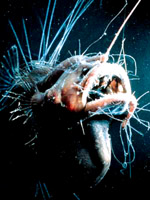
Angler fish |
|

Fang tooth |
It is not just the numerous wonders around us on Earth that are
mind-boggling, but all that is in the depths of the oceans and way out
in outer space... However, you will be surprised to learn that we know
more about outer space today than we know about the deep oceans right
here on our planet.
Even though scientists have succeeded in making space shuttles to
explore the universe and even give humans the opportunity to 'walk' on
the Moon, the technological advances made in exploring the depths of the
ocean haven't progressed so far.
What has been discovered todate about the mysterious deep, dark
oceans have been done with the aid of hi-tech submersibles, most often
functioning on their own without any humans in them.
|
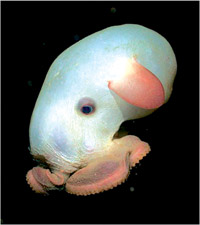
Dumbo octopus |
|

Giant isopod |
Now, if you are wondering why we cannot dive in to the depths of the
oceans beyond a certain point, here's the reason; the pressure in the
deepest areas of the ocean is very high that humans and even most
animals cannot withstand it except for a few creatures who are
especially adapted to these conditions.
Most of the information gathered so far has been from inside
tethered(chained) metal balls called bathyspheres and modern
submersibles.
Scientists have succeeded in sending into the deep, the region below
650 feet from the sunlit surface, remotely operated underwater vehicles
(ROVs) equipped with cameras to photograph the life forms in the deep.
|

Two more creatures from the deep |
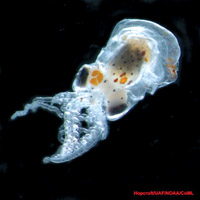 However,
they claim that it is not possible to capture and bring to surface most
of the creatures from the deep because a majority of them do not
survive. In fact, some fish even explode when they are brought to the
surface because they are made in such a way to only withstand the high
pressure below in the deep. However,
they claim that it is not possible to capture and bring to surface most
of the creatures from the deep because a majority of them do not
survive. In fact, some fish even explode when they are brought to the
surface because they are made in such a way to only withstand the high
pressure below in the deep.
Even though the information uncovered so far about these monster-like
creatures is limited, what the scientists have gathered is so
fascinating. So, today, let's take a trip into the deep to learn more
about life in the ocean depths...
Most of you must be aware that the deepest part of the oceans is
located off Mariana Islands (in the Pacific Ocean) and is called the
Mariana Trench. The deepest point here is the Challenger Deep and is
recorded to be 10,923 mts (35,838 ft) or 6.7875 miles below sea level.
The pressure is said to be 1095 times that of the surface, or over
16,000 pounds per square inch.
|
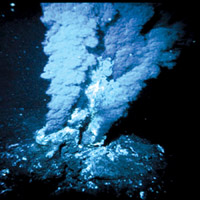
A hydrothermal vent |
The deepest point is called the abyssal zone and is home to thousands
of species of invertebrates and fish such as Angler fish. As it is very,
very cold down at the bottom, with no sunlight and little food, the life
forms live under extreme conditions.
How can these creatures move about in the pitch dark and find their
food, you may wonder. It has been revealed even through the recent
observations, that generally, most of these creatures float around, and
wait for the food to come their way rather than hunt for food and waste
their energy.
They sense their prey through smell, taste and touch because most
creatures are blind; they have tiny eyes or no eyes at all. Some fish
have large eyes that pick up any faint glimmer of light or tube-shaped
eyes which they use like binoculars.
A line of nerves running through the fish's body picks up vibrations
in the water caused by other swimming creatures. Some deep sea creatures
have long touch and tastesensitive tentacles trailing from their jaws.
Some fish use the light created by the others to hunt for food which
is scarce in the deep. The main food in the deep which the scientists
call 'Marine Snow' is flakes of dead things and faecal matter that drift
down from the bright ocean.
|
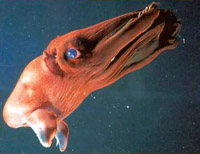
Vampire squid |
|
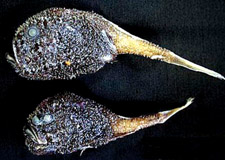
Firefly squid |
Other deep-sea food is obtained from hydrothermal vents, cracks in
the ocean floor where water mixes with magma and erupts in hot, sulphur-rich
plumes. Microbes have evolved a way to convert the chemicals from these
vents into energy.
One animal that thrives near these vents is the vent crab. More than
300 species such as blind crabs, giant white crabs and a variety of tube
worms are believed to exist at these vents which are virtual witches'
cauldrons 'consisting of deadly toxins, the foremost of which is
hydrogen sulphide.
Even though it's good for microbes, it's lethal(deadly) for other
organisms. The tiny microbes oxidize (to combine with oxygen ) the
hydrogen sulphide providing nutrients for animals higher up in the food
chain.
Some, like the gastropod snails, feed on the bacteria directly,
others eat the animals that have consumed these microbes. Tube worms
host the micro-organisms in their tissue in exchange for organic
compounds the bacteria feed on from the vent.
|

Long-nosed chimera |
|

A transparent creature from the deep. |
The majority of creatures living in the abyssal zone are bizarre in
appearance. In fact, they are more like monsters from a horror movie.
Some have large heads and huge mouths with fierce looking teeth.
Most have long, thin bodies which are either dark coloured (mostly
black) to match the inky waters, transparent or silvery coloured,
reflecting any small gleam of light, made mostly by the luminous
bacteria, some of which live under the skin of certain creatures.
Most deep-sea animals have a cell that produces light. They float
about flashing 'neon' lights in the pitch dark, looking like monsters.
But, despite their bizarre appearance, these creatures are rather small,
not more than 30 cm long in most instances.
The Gulper eel, Giant squid, Giant Isopod Coffin fish, Vampire,
Squid, Viper fish, Fang tooth, Dragon fish, Angler fish and the
Long-nosed Chimera are just ten of the horrible looking deep sea
creatures identified.
Grimpoteuthis are a type of Dumbo octopus which lives in every ocean
near the bottom. Researchers have already described fourteen species of
them. The reason they are called 'Dumbo octopuses' are because of their
ear-like fins protruding from the top of their heads, resembling Walt
Disneys' flying elephant, Dumbo.
They are the rarest of the Octopoda species. Another deep sea
creature found recently is the small Benthocodon jelly which lives near
sea mountains, some of which are said to dwarf the highest mountains on
land - the Himalayas.
The discoveries made so far are unimaginable because scientists claim
that majority of the animals hauled up are hitherto unknown. According
to Clair Nouvian (French documentary producer), bioluminesces in the
deep are more dramatic than the dramatic skies with shooting stars!
****
Fact file
* The deep sea is the world's largest ecosystem on Earth plunging to
more than 37,000 feet below sea level, at the Mariana Trench.
* The world's first deep-sea submersible Alvin was constructed in the
1960s for the US Navy. It was a capsule-like submarine, nearly eight
metres long. Three persons could travel in this self-propelling
submersible.
* What lives in the very depths of the ocean is called ooze. It's a
greyish, yellowish tarnished ooze, which is butter-like, slippery and
very cold to the touch. It is made up of age-old sediments of plankton
and dead bodies that fall to the ocean floor. Four types of ooze have
been identified by scientists. They are: red clay, globigerina ooze,
radiolarian ooze and pteropod ooze.
* At the greatest depths of the ocean, water pressure can equal about
eight tons per square inch because the liquid nature of water is exerted
in all directions. Generally pressure increases by 15 pounds a square
inch for every 30 feet.
* The latest book titled 'The Deep' (The University of Chicago Press)
by French documentary film producer Clair Nouvian containing more than
200 photographs taken from submersibles and ROVs gives a comprehensive
look at the bizarre and mysteriouslife that exists below in the deepest
part of the oceans, called the abyss, by many a scientist.
Nouvian herself has made two dives to 3,200 ft in submersibles.
* Most deep sea creatures have a single cell that have the ability to
cause a chemical reaction that gives off light.
* The name 'Challenger Deep' was given to the deepest point on Earth
following the British survey ship HMS Challenger which was used to
pinpoint the area. The HMS Challenger Expedition was carried out between
December 1872-1876.
The first echo sounding about the deepest point was made on March 23,
1875. It was in 1951 that the entire Mariana Trench was surveyed by the
HMS Challenger.
* Vent animals have no air pockets such as lungs which would be
crushed flat at depths of 7,500 ft.
* Vents are spread far and wide throughout the world.
* With no plant life and no photosynthesis, the deep sea creatures
survive through chemosynthesis; they do not rely on protons from the
Sun, but chemicals from the Earth's interior.
* The highest temperature bacteria can withstand is 113 degrees
Celsius (235 degrees Fahrenheit) while the highest temperature any
animal can withstand is 50 degrees Celsius (122 degrees F). |
